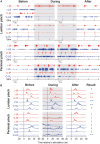Inhibition and Facilitation of the Spinal Locomotor Central Pattern Generator and Reflex Circuits by Somatosensory Feedback From the Lumbar and Perineal Regions After Spinal Cord Injury
- PMID: 34393721
- PMCID: PMC8355562
- DOI: 10.3389/fnins.2021.720542
Inhibition and Facilitation of the Spinal Locomotor Central Pattern Generator and Reflex Circuits by Somatosensory Feedback From the Lumbar and Perineal Regions After Spinal Cord Injury
Abstract
Somatosensory feedback from peripheral receptors dynamically interacts with networks located in the spinal cord and brain to control mammalian locomotion. Although somatosensory feedback from the limbs plays a major role in regulating locomotor output, those from other regions, such as lumbar and perineal areas also shape locomotor activity. In mammals with a complete spinal cord injury, inputs from the lumbar region powerfully inhibit hindlimb locomotion, while those from the perineal region facilitate it. Our recent work in cats with a complete spinal cord injury shows that they also have opposite effects on cutaneous reflexes from the foot. Lumbar inputs increase the gain of reflexes while those from the perineal region decrease it. The purpose of this review is to discuss how somatosensory feedback from the lumbar and perineal regions modulate the spinal locomotor central pattern generator and reflex circuits after spinal cord injury and the possible mechanisms involved. We also discuss how spinal cord injury can lead to a loss of functional specificity through the abnormal activation of functions by somatosensory feedback, such as the concurrent activation of locomotion and micturition. Lastly, we discuss the potential functions of somatosensory feedback from the lumbar and perineal regions and their potential for promoting motor recovery after spinal cord injury.
Keywords: cutaneous; locomotion; lumbar; micturition; perineal; somatosensory feedback; spinal cord injury; spinal reflexes.
Copyright © 2021 Merlet, Harnie and Frigon.
Conflict of interest statement
The authors declare that the research was conducted in the absence of any commercial or financial relationships that could be construed as a potential conflict of interest.
Figures


Similar articles
-
Mechanically stimulating the lumbar region inhibits locomotor-like activity and increases the gain of cutaneous reflexes from the paws in spinal cats.J Neurophysiol. 2020 Mar 1;123(3):1026-1041. doi: 10.1152/jn.00747.2019. Epub 2020 Feb 12. J Neurophysiol. 2020. PMID: 32049598
-
Cutaneous inputs from perineal region facilitate spinal locomotor activity and modulate cutaneous reflexes from the foot in spinal cats.J Neurosci Res. 2021 May;99(5):1448-1473. doi: 10.1002/jnr.24791. Epub 2021 Feb 1. J Neurosci Res. 2021. PMID: 33527519
-
Probing the Human Spinal Locomotor Circuits by Phasic Step-Induced Feedback and by Tonic Electrical and Pharmacological Neuromodulation.Curr Pharm Des. 2017;23(12):1805-1820. doi: 10.2174/1381612822666161214144655. Curr Pharm Des. 2017. PMID: 27981912 Review.
-
Rapid recovery and altered neurochemical dependence of locomotor central pattern generation following lumbar neonatal spinal cord injury.J Physiol. 2018 Jan 15;596(2):281-303. doi: 10.1113/JP274484. Epub 2017 Dec 3. J Physiol. 2018. PMID: 29086918 Free PMC article.
-
The neural control of interlimb coordination during mammalian locomotion.J Neurophysiol. 2017 Jun 1;117(6):2224-2241. doi: 10.1152/jn.00978.2016. Epub 2017 Mar 15. J Neurophysiol. 2017. PMID: 28298308 Free PMC article. Review.
Cited by
-
Spinal sensorimotor circuits play a prominent role in hindlimb locomotor recovery after staggered thoracic lateral hemisections but cannot restore posture and interlimb coordination during quadrupedal locomotion in adult cats.bioRxiv [Preprint]. 2023 Mar 25:2023.03.23.533936. doi: 10.1101/2023.03.23.533936. bioRxiv. 2023. Update in: eNeuro. 2023 Jun 23;10(6):ENEURO.0191-23.2023. doi: 10.1523/ENEURO.0191-23.2023. PMID: 36993268 Free PMC article. Updated. Preprint.
-
Neurons Are Not All the Same: Diversity in Neuronal Populations and Their Intrinsic Responses to Spinal Cord Injury.ASN Neuro. 2025;17(1):2440299. doi: 10.1080/17590914.2024.2440299. Epub 2025 Jan 16. ASN Neuro. 2025. PMID: 39819292 Free PMC article. Review.
-
Changes in intra- and interlimb reflexes from forelimb cutaneous afferents after staggered thoracic lateral hemisections during locomotion in cats.bioRxiv [Preprint]. 2024 Apr 23:2024.04.23.590723. doi: 10.1101/2024.04.23.590723. bioRxiv. 2024. Update in: J Physiol. 2024 May;602(9):1987-2017. doi: 10.1113/JP286151. PMID: 38712151 Free PMC article. Updated. Preprint.
-
How Does the Central Nervous System for Posture and Locomotion Cope With Damage-Induced Neural Asymmetry?Front Syst Neurosci. 2022 Mar 3;16:828532. doi: 10.3389/fnsys.2022.828532. eCollection 2022. Front Syst Neurosci. 2022. PMID: 35308565 Free PMC article. Review.
-
Changes in intra- and interlimb reflexes from hindlimb cutaneous afferents after staggered thoracic lateral hemisections during locomotion in cats.J Physiol. 2024 May;602(9):1987-2017. doi: 10.1113/JP286151. Epub 2024 Apr 9. J Physiol. 2024. PMID: 38593215 Free PMC article.
References
Publication types
LinkOut - more resources
Full Text Sources
Miscellaneous

